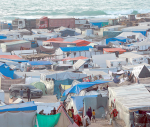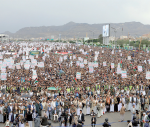You are here
Qatar economy to power ahead despite oil slump — bank
By AFP - Sep 08,2015 - Last updated at Sep 08,2015
DOHA — Super-rich Qatar will withstand plummeting global oil prices and its economy will expand by almost 7 per cent in both 2016 and 2017, a major bank reported Tuesday.
Despite its reliance on oil and gas, Qatar's economy will be powered by major infrastructure projects, including the building of a new city where the 2022 football World Cup final will be played, a rail network and a mega-reservoirs project.
A $226-billion (202-billion-euro) spending programme by the tournament host will see real gross domestic product, the figure adjusted after inflation, grow 4.7 per cent this year and 6.4 per cent in each of the two following years, predicted Qatar National Bank (QNB).
"We expect growth in Qatar to remain strong despite lower oil prices," said the bank in its "Qatar Economic Insight 2015" report.
"The government has repeatedly expressed its commitment to continue the investment spending programme and its efforts to diversify the economy," it added.
The QNB said Doha can shrug off the fall in world oil prices as its breakeven oil price is "low" at $60.7 per barrel. It has more than $315 billion in savings and public debt is low.
Earlier this week, Qatar's Finance Minister Ali Sherif Al Emadi, said Doha would not scale back on its major economic projects even though other countries in the Gulf have begun to curb spending.
Oil-flush neighbour and regional powerhouse Saudi Arabia on Sunday said it would cut spending and issue more bonds as it faces up to a record budget shortfall due to tumbling crude prices.
Riyadh's unprecedented deficit is hitting as the kingdom maintains a costly military intervention against Iran-backed Huthi rebels in neighbouring Yemen as part of a coalition that includes Qatar.
On the back of sustained economic growth, the QNB predicts that Qatar's population will top 2.5 million for the first time by the end of 2016.
It only reached one million in 2006.
The current population stands at around 2.3 million, with 75 per cent of those men, which the United Nations estimates as the highest male to female ratio in the world.
Related Articles
Qatar's economy grew by more than 6 per cent in 2014, official figures showed, driven by spending on huge construction projects ahead of the 2022 World Cup.
DOHA — Qatar's budget should be back to "near balance" by 2018, as it overcomes the shock waves from a global fall in energy prices, economi
DOHA — Qatar's ruler said Tuesday he hoped the global fall in energy prices would help reduce dependency on the state in the oil-rich Gulf n

















